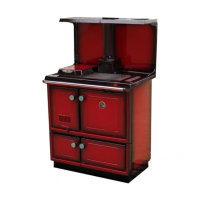The effective free area of any vent should be ascer-
tained before installation. The effect of any screen
should be allowed for when determining the effec-
tive free area of any vent.
Air vents direct to the outside of the building should
be located so that any air current produced will not
pass through normally occupied areas of the room.
An air vent outside the building should not be locat-
ed less than the dimensions specified within the
Building Regulations from any part of any flue ter-
minal. These air vents must also be fire proofed as
per Building Regulations.
Air vents in internal walls should not communicate
with bedsits, toilets, bathrooms or rooms containing
a shower.
Air vents traversing cavity walls should include a
continuous duct across the cavity. The duct should
be installed in such a manner as not to impair the
weather resistance of the cavity.
Joints between air vents and outside walls should
be sealed to prevent the ingress of moisture.
Existing air vents should be of the correct size and
unobstructed for the appliance in use.
IF THERE IS AN AIR EXTRACTION FAN FITTED
IN THE ROOM OR ADJACENT ROOMS WHERE
THIS APPLIANCE IS FITTED, ADDITIONAL AIR
VENTS WILL BE REQUIRED TO ELEVIATE THE
POSSIBILITY OF SPILLAGE OF PRODUCTS OF
COMBUSTION FROM THE APPLIANCE/FLUE
WHILE THE FAN IS IN OPERATION.
Where such a installation exists, a test for spillage
should be made with the fan or fans and other
appliances using air in operation at full rate, (i.e.
extraction fans, tumble dryers) with all external
doors and windows closed.
If spillage occurs following the above operation, an
additional air vent of sufficient size to prevent this
occurrence should be installed.
provided that its construction, condition and dimen-
sions are acceptable. Flues that have proved to be
unsatisfactory, particularly with regard to down
draught, should not be considered for venting this
appliance until they have been examined and any
faults corrected. If there is any doubt about an
existing chimney a smoke test should be carried
out.
Before connecting this appliance to a chimney or
flue pipe which has previously been used with
another flue, the chimney or flue pipe should be
thoroughly swept.
ALL CHIMNEY’S MUST BE SUITABLY LINED
(Removal of debris should be facilitated by the pro-
vision of an access door). This void should have a
depth not less than 250mm (10”) below the appli-
ance connection.
VENTILATION & COMBUSTION AIR REQUIRE-
MENTS
IT IS IMPERATIVE THAT THERE IS SUFFICIENT
AIR SUPPLY TO THE COOKER IN ORDER TO
SUPPORT CORRECT COMBUSTION.
NEVER COVER OR CLOSE AIR VENTS
The air supply to this appliance must comply with
B.S. 8303: Part 1.
The minimum effective air requirement for this
appliance is 92cm
2
(47K) or 65cm
2
(30K). When
calculating combustion air requirement for this
appliance use the following equation: a total free
area of at least 550mm
2
per kW of rated output
above 5kW shall be provided. Where a flue draught
stabiliser is used the total free area shall be
increased by 300mm
2
for each kW of rated output.
If there is another appliance using air fitted in the
same or adjacent room, it will be necessary to cal-
culate additional air supply.
All materials used in the manufacture of air vents
should be such that the vent is dimensionally stable
and corrosion resistant.
RADIATOR
HEATING
CIRCUITS
CYLINDER
HEATING
CIRCUIT
PIPE FUNCTION PIPE FUNCTION
FIRST
FLOOR
1 PUMPED FLOW TO RADIATORS 7 HOT WATER FLOW
2 PUMPED RETURN EX 8 COLD WATER (EX TANK)
GROUND
FLOOR
3 PUMPED FLOW TO RADIATORS 9 COOL FEED-HEAT SYSTEM
4 PUMPED RETURN TO EX 10 OPEN VENT-HEAT SYSTEM
FIRST
FLOOR
5
6
GRAVITY FLOW TO CYLINDER 11 COLD FEED TO CYLINDER
GRAVITY RETURN EX 12 HOT WATER VENT
13 MAINS WATER
T THERMOSTAT
ISOLATING VALVES
PLUMBING
6

